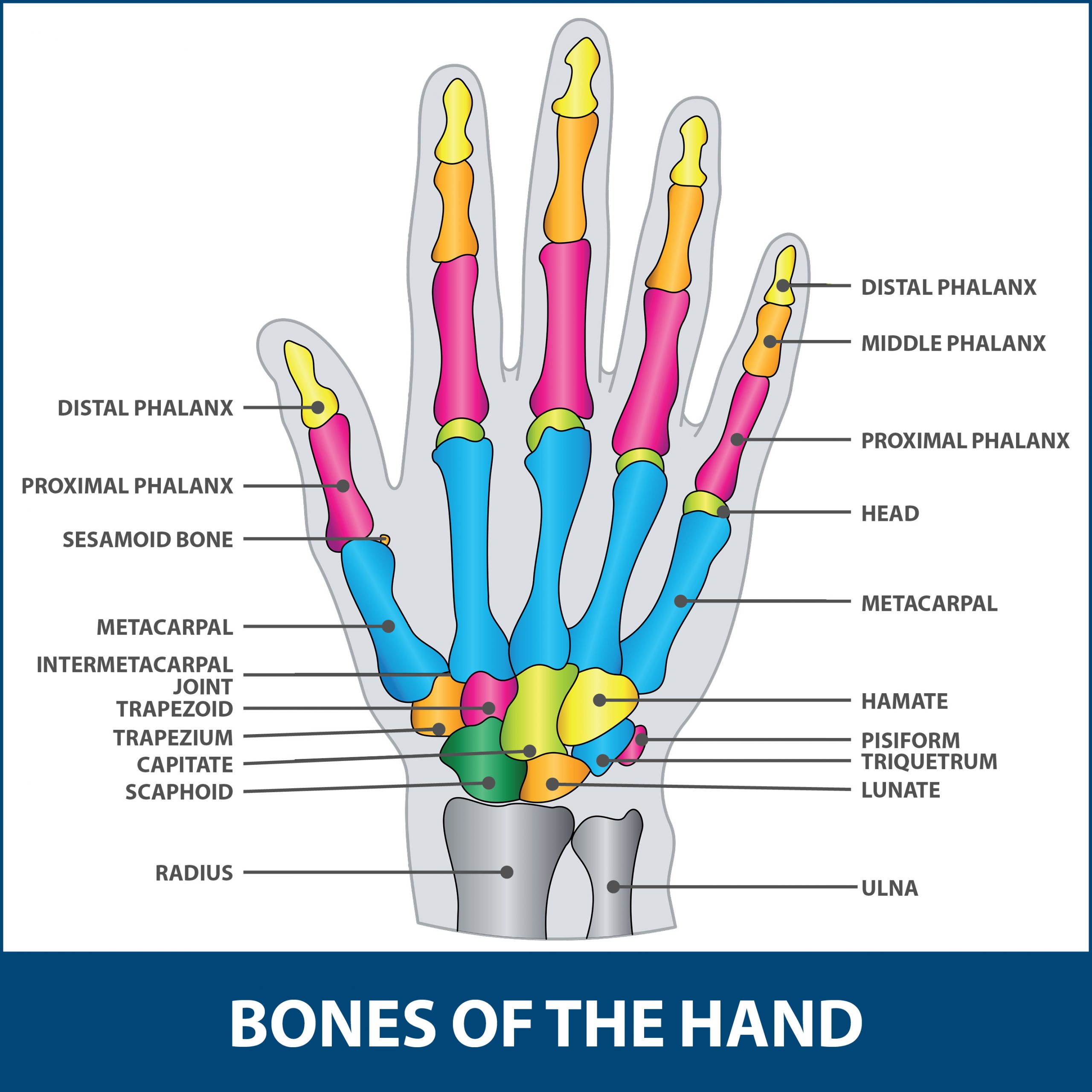FRACTURED FINGERS
Overview
Few physical features play as crucial a role in your ability to perform routine activities, like lifting, holding, and carrying objects more than the fingers.
Unfortunately, when your hands sustain an injury, you can experience great pain and possibly even disability. Especially concerning injuries are finger fractures.
Anatomy
The fingers are made up of 14 bones scientifically called phalanges. Additionally, the palm contains five bones that attach to the phalanges, which are called metacarpals.

Description
Fractures or breakages of these bones often results from blunt trauma or from weakening produced by disease.
Causes
In most instances, finger fractures are the result of an acute, forceful injury, including:
- A hard fall.
- Athletic competition-related contact.
- Accidentally jamming a hand inside a doorway.
- Automobile accidents.
- Slamming a hand down in anger or frustration.
Occasionally, finger fractures might result from illnesses such as osteoporosis or various forms of cancer. Bone fractures brought forth by a disease are medically known as pathological breaks.

Symptoms
Finger fractures often produce pain. This discomfort can be intense and usually begins immediately following an acute injury. Other symptoms might include:
- Redness around the finger.
- Significant swelling.
- Tenderness to the touch.
- A feeling of warmth surrounding the affected bone.
Moderate to severe fractures might produce more serious concerns, such as deformity of the broken finger and the inability to move it.
Complications
A fractured finger greatly reduces the capacity to engage in any action involving the hands. Efforts that need gripping, holding onto an object, or lifting items off a surface could prove challenging and, in some cases, impossible.
Diagnosis
Those who have sustained a finger fracture should seek medical attention as soon as possible. Patients actually play an important role in helping a doctor confirm the diagnosis and prescribe the most appropriate treatment.
You are encouraged to be as detailed as possible with your examining physician. Describing the events leading up to the break-causing event will help your physician discover the specific bone that split, in addition to the way the fracture occurred. Breaks can happen in a spiral formation, straight across, splinter into many pieces, or entirely shatter.
The first stage of the diagnostic process will involve a physician performing a visual examination and requesting that you perform certain movement tests. Your doctor might use imaging devices like X-rays to confirm the diagnosis and assess how serious the fracture is.
Treatment Overview
Like many other physical injuries, the severity will determine the type of treatment and how aggressive such efforts must be. Fortunately, a large percentage of finger fractures do not require surgery. Significant or complicated fractures may need surgical intervention.
Non-Surgical Treatment Options
Physicians can usually reposition mild to moderate finger fractures. After completing this process, the physician will likely place the injured finger inside a supporting device such as a splint or cast. This will ensure the finger remains in a fixed position, promoting healing and reducing the risk of encountering further damages.
Individuals heal at their own pace. Establishing recovery time frames often proves challenging. On average, supporting devices are worn for roughly three weeks.
Once removed from a splint or cast, many physicians advise to have some form of rehabilitative therapy. These exercises help the finger regain the strength and mobility it might have lost while immobilized.
Surgical Procedures
When an operation is required to correct finger fractures, surgeons usually realign broken digits using objects like pins, wires, and screws. Following the procedure, the patient’s finger is typically immobilized anywhere from four to six weeks.
Occasionally, the hardware placed inside the fractured bone is removed. Those materials may be left inside the affected bone to ensure proper healing and to prevent bone shifting.
Following removal of the stabilizing device, the patient typically begins physical therapy lasting for up to three months. In total, recovery from finger fracture surgery can take as long as four months.
Prevention
Since many finger fractures result from sudden and unexpected accidents, prevention is not always easy. That said, doctors caution patients to place significant emphasis on safety. This means protecting your hands whenever possible and refraining from reckless actions that could put the health of your hands in jeopardy.
Next Steps
Finger fractures are serious physical injuries needing immediate medical attention. Talk to your Florida Orthopaedic Institute physician today to learn more about Fractured Fingers.
Areas of Focus
- Hand & Wrist
- Basal Joint Surgery
- Carpal Tunnel Syndrome
- Colles’ Fractures (Broken Wrist)
- De Quervain's Tenosynovitis
- Dupuytren’s Disease
- Finger Dislocation
- Flexor Tendonitis
- Fractured Fingers
- Functional Nerve Transfers of The Hand
- Ganglion Cysts
- Hand & Finger Replantation
- Hand Nerve Decompression
- Hand Skin Grafts
- Nerve Pain
- Peripheral Nerve Surgery (Hand) Revision
- Revascularization of the Hand
- Rheumatoid Arthritis Of The Hand
- Sports Wrist and Hand Injuries
- Sprained Wrist Symptoms and Treatment
- Sudden (Acute) Finger, Hand & Wrist Injuries
- Targeted Muscle Reinnervation (TMR)
- Tendon Transfers of The Hand
- Thumb Ulnar Collateral Ligament Injuries
- Trigger Finger
- Ulnar Neuritis
- WALANT (Wide Awake Local Anesthesia No Tourniquet)
- Wrist Arthroscopy
- Wrist Fractures
- Wrist Tendonitis
Specialties
- AC Joint Injuries
- Achilles Tendinitis - Achilles Insertional Calcific Tendinopathy (ACIT)
- Achilles Tendon Rupture
- Achilles Tendonitis
- ACL Injuries
- Ankle Fracture Surgery
- Ankle Fractures (Broken Ankle)
- Ankle Fusion Surgery
- Anterior Cervical Corpectomy & Discectomy
- Arthroscopic Articular Cartilage Repair
- Arthroscopic Chondroplasty
- Arthroscopic Debridement of the Elbow
- Arthroscopy Of the Ankle
- Articular Cartilage Restoration
- Artificial Disk Replacement (ADR)
- Aspiration of the Olecranon Bursa - Fluid In Elbow
- Atraumatic Shoulder Instability
- Avascular Necrosis (Osteonecrosis)
- Bankart Repair
- Basal Joint Surgery
- Bicep Tendon Tear
- Bicep Tenodesis
- Bone Cement Injection
- Bone Growth Stimulation
- Bone Health Clinic
- Broken Collarbone
- Bunions
- Bursitis of the Shoulder (Subacromial Bursitis)
- Calcific Tendinitis of the Shoulder
- Carpal Tunnel Syndrome
- Charcot Joint
- Chiropractic
- Clavicle Fractures
- Colles’ Fractures (Broken Wrist)
- Common Foot Fractures in Athletes
- Community Outreach
- Cubital Tunnel Syndrome
- De Quervain's Tenosynovitis
- Deep Thigh Bruising
- Degenerative Disk Disease
- Diffuse Idiopathic Skeletal Hyperostosis (DISH)
- Discectomy
- Discitis Treatment & Information
- Dislocated Shoulder
- Dupuytren’s Disease
- Elbow
- Elbow Bursitis
- Elbow Injuries & Inner Elbow Pain in Throwing Athletes
- Epidural Injections for Spinal Pain
- Finger Dislocation
- Flexor Tendonitis
- Foot Stress Fractures
- Foot, Ankle & Lower Leg
- Foraminotomy
- Fractured Fingers
- Fractures Of The Shoulder Blade (Scapula)
- Fractures Of The Tibial Spine
- Functional Nerve Transfers of The Hand
- Ganglion Cysts
- General Orthopedics
- Glenoid Labrum Tear
- Golfer's Elbow
- Groin Strains and Pulls
- Growth Plate Injuries Of The Elbow
- Hallux Rigidus Surgery - Cheilectomy
- Hammer Toe
- Hamstring Injuries
- Hand & Finger Replantation
- Hand & Wrist
- Hand Nerve Decompression
- Hand Skin Grafts
- Hand, Wrist, Elbow & Shoulder
- Heat Injury/Heat Prostration
- High Ankle Sprain (Syndesmosis Ligament Injury)
- Hip & Thigh
- Hip Arthroscopy
- Hip Dislocation
- Hip Flexor Strains
- Hip Fractures
- Hip Hemiarthroplasty
- Hip Impingement Labral Tears
- Hip Muscle Strains
- Hip Pointers and Trochanteric Bursitis
- Hyperextension Injury of the Elbow
- Iliopsoas Tenotomy
- Iliotibial Band Syndrome
- Impingement Syndrome of the Shoulder
- Interlaminar Implants
- Interlaminar Lumbar Instrumental Fusion: ILIF
- Interventional Pain Management
- Interventional Spine
- Intraarticular Calcaneal Fracture
- Joint Replacement
- Knee & Leg
- Kyphoplasty (Balloon Vertebroplasty)
- Kyphosis
- Labral Tears Of The Hip (Acetabular Labrum Tears)
- Laminectomy: Decompression Surgery
- Lateral Collateral Ligament (LCL) Injuries
- Lisfranc Injuries
- Little League Shoulder
- LITTLE LEAGUER'S ELBOW (MEDIAL APOPHYSITIS)
- Lumbar Epidural Steroid Injection
- Lumbar Interbody Fusion (IBF)
- MACI
- Mallet, Hammer & Claw Toes
- Medial Collateral Ligament Injuries
- Meniscus Tears
- Metatarsalgia
- Minimally Invasive Spine Surgery
- Morton’s Neuroma
- Muscle Spasms
- Muscle Strains of The Calf
- Nerve Pain
- Neuromas (Foot)
- Neurosurgery
- Olecranon Stress Fractures
- Orthopaedic Total Wellness
- Orthopaedic Trauma
- Orthopedic Physician Or A Podiatrist? Definition of a Podiatrist
- Osteoarthritis of the Hip
- Osteoporosis
- Outpatient Spine Surgery
- Partial Knee Replacement
- Patellar Fracture
- Pelvic Ring Fractures
- Peripheral Nerve Surgery (Hand) Revision
- Pinched Nerve
- Piriformis Syndrome
- Piriformis Syndrome
- Plantar Fasciitis
- Plastic Surgery
- Podiatry
- Primary Care Sports Medicine
- Quadriceps Tendon Tear
- Radial Tunnel Syndrome (Entrapment of the Radial Nerve)
- Revascularization of the Hand
- Reverse Total Shoulder Replacement
- Rheumatoid Arthritis (RA) of the Shoulder
- Rheumatoid Arthritis Of The Hand
- Robotics
- Rotator Cuff Tears
- Runner's Knee
- Sacroiliac Joint Pain
- Sciatica
- Scoliosis
- Senior Strong
- Shin Splints
- Shoulder
- Shoulder Arthritis
- Shoulder Arthroscopy
- Shoulder Injury: Pain In The Overhead Athlete
- Shoulder Replacement
- Shoulder Separations
- Shoulder Socket Fracture (Glenoid Fracture)
- SLAP Tears & Repairs
- Spinal Fusion
- Spine
- Spondylolisthesis and Spondylolysis
- Sports Foot Injuries
- Sports Hernias (Athletic Pubalgia)
- Sports Medicine
- Sports Wrist and Hand Injuries
- Sprained Ankle
- Sprained Wrist Symptoms and Treatment
- Subacromial Decompression
- Sudden (Acute) Finger, Hand & Wrist Injuries
- Targeted Muscle Reinnervation (TMR)
- Tendon Transfers of The Hand
- Tennis Elbow Treatment
- Thigh Fractures
- Thigh Muscle Strains
- Thumb Ulnar Collateral Ligament Injuries
- Total Ankle Replacement
- Total Hip Arthroplasty
- Total Hip Replacement - Anterior Approach
- Total Knee Replacement Surgery
- Trapezius Strain (Muscle Strain of The Upper Back)
- Traumatic Shoulder Instability
- Tricep Pain & Tendonitis
- Trigger Finger
- Turf Toe
- UCL (Ulnar Collateral Ligament) Injuries
- Ulnar Neuritis
- Valgus Extension Overload
- Vertebroplasty
- WALANT (Wide Awake Local Anesthesia No Tourniquet)
- Whiplash and Whiplash Associated Disorder (WAD)
- Wound Care
- Wrist Arthroscopy
- Wrist Fractures
- Wrist Tendonitis
Services
- Physical Medicine & Rehabilitation
- Physical Therapy
- Primary Care Sports Medicine
- PROMs (Patient-Reported Outcome Measures)
- Same-Day Orthopaedic Appointments Now Available
- Sports Medicine
- Sports-Related Concussion Treatment
- Telehealth Page
- Telemedicine
- Workers' Compensation
- Workers' Compensation Dispensary
- X-Ray
